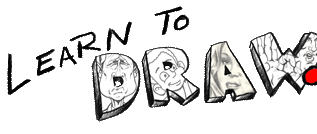 |
|
Study as many faces as you can |
In order to do a good caricature you have to know
and understand what it is you're drawing. Look at
pictures of people in magazines and look at your family
photo albums. Stare at people as you pass them on the
street. Look at faces and see if you can visualize a
caricature of that face. Study your subject. Look at the
face from as many angles as you can. This is why drawing
from life - when the person being drawn is sitting right
in front of you - is infinitely easier than drawing from
a two dimensional photograph. Being able to see the
person "in the round" is best because you can get a
"whole" sense of the person, rather than a two
dimensional sense that some photographer gives you. You
may be handed a photo of Jay Leno shot from above his
head which would make his noggin look huge and his chin
look small. The resulting caricature would be pretty
nasty. Find as many photos of your subject as possible
and try and get a sense of what they really look like.
Notice the facial features in relation to one another.
Does the hair recede and thus make the forehead look
huge? Do they have an overbite and thus make the chin
look small? Do their ears stick out unusually far from
their head? Do their eyes seem too close together? Are
their eyes horizontally aligned? (have you looked at
Shannon Doherty's eyes?) Is their nose hooked or does it
curve upward? After this intense study, try to visualize
a completed caricature in your head.
 Here's
a basic question you may be asking: "How do I know which
features to exaggerate on the face?" Here's
a basic question you may be asking: "How do I know which
features to exaggerate on the face?"
 |
|
Visualize the caricature you want to draw |
Here's an answer: You'll know by looking at a face. If
you have a mental picture in your head of what an
"average" face would look like, compare that face to the
face you're looking at, and note the differences.
Sometimes it's obvious, sometimes the dude's nose is
just too large for his head. Or her ears are so large
she could flap them and fly away. Caricaturing isn't
always "exaggeration", it's also minimizing features as
well as maximizing them. Maybe you're thinking "How can
she be such a loudmouth with such a small mouth?" Look
at the person and gauge the relative sizes of one facial
feature against the other facial feature. The features
of the subject should only be compared to their own
features. If you have two people in a drawing and the
first person has a larger nose than the second person,
don't give the first person a large nose if he really
doesn't have one in relation to his own face. |
